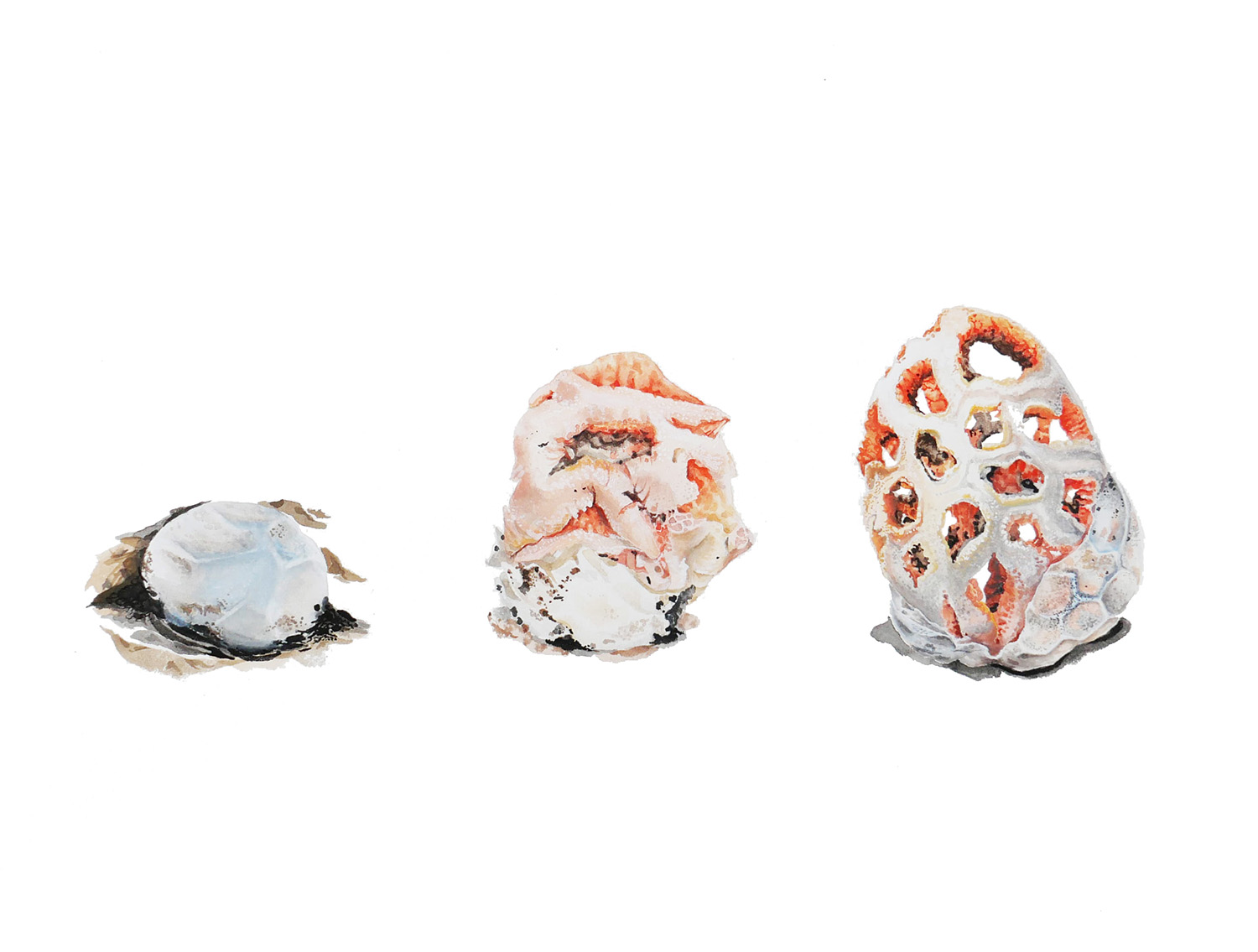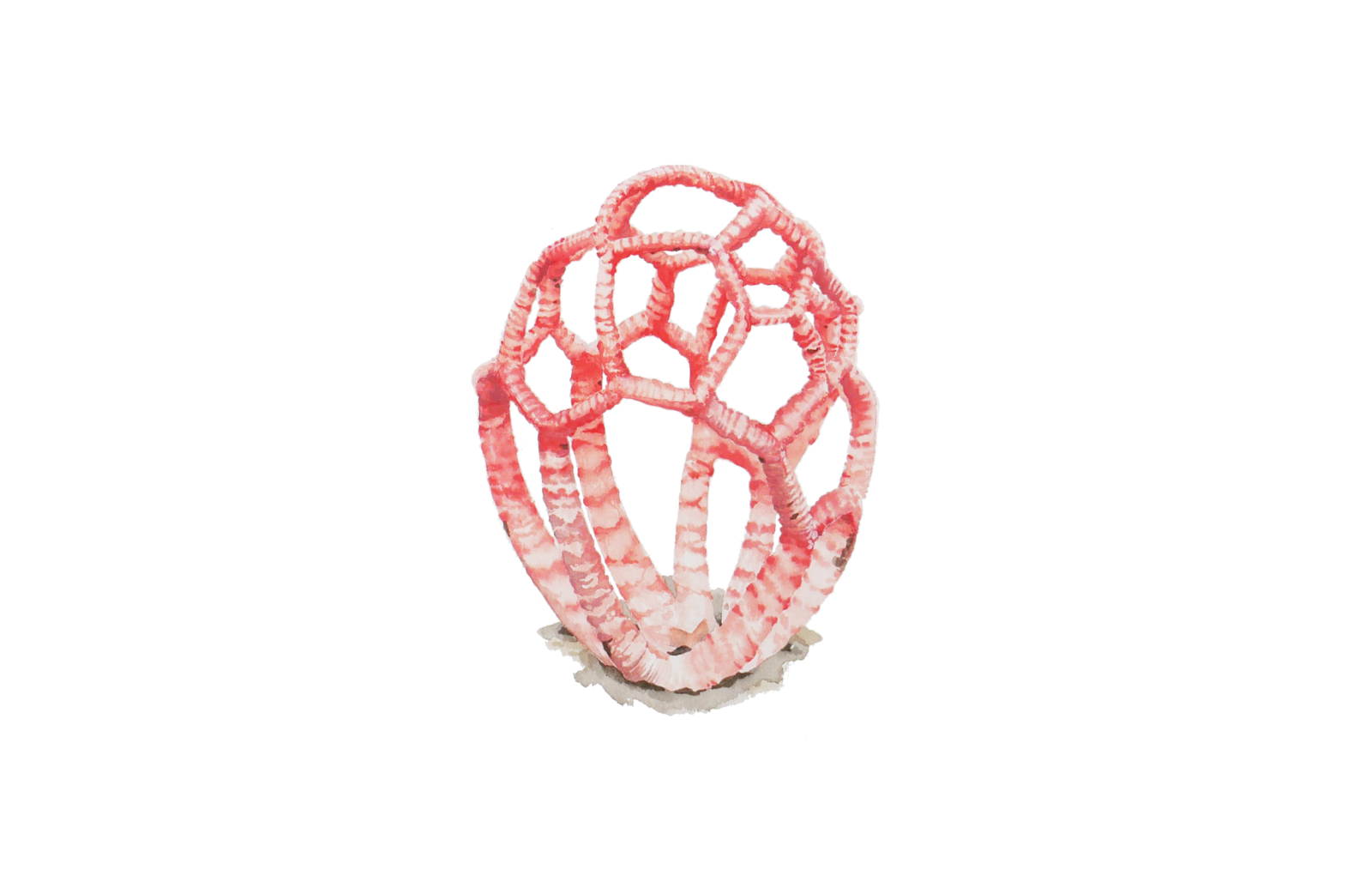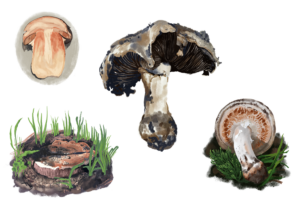In a world of weird mushrooms, Clathrus ruber stands out as a particularly weird mushroom: a geometric pop of orange-red appearing in gardens and parks after the rains, looking more like an errant pickleball than a traditional toadstool. A member of the order Phallales, known commonly as stinkhorns, C. ruber has been called the basket stinkhorn, latticed stinkhorn, or red cage fungus (clathrus meaning cage or lattice in ancient Greek, ruber meaning red in Latin), witch’s heart in eastern Europe, and lanterne du diable (devil’s lantern) in France. This cosmopolitan character was first described in Europe, and is considered native to the Mediterranean region. It has also been seen in Australia, Asia and Central and South America. In the US, it appears primarily along the California coast.
Like all stinkhorns, C. ruber begins its life above ground as a dirty white little “egg”, peeking out from soil and detritus. With time the egg can start to show the faint edges of the geometric shape growing within. Once the mushroom inside is mature enough, it bursts upward out of the egg, and in a matter of minutes is a fully formed, fully bizarre structure. The mature cage stinkhorn looks like a demonic bucky ball that you might want to use as a loofah.

C. ruber’s cage bears one of those surprising natural geometries, like the Fibonacci sequences of nautiluses or the fractals of romanesco broccoli, that seem more engineered than grown. As if a crew of enterprising ants, wanting to impress all the other insects, had erected this impressive mushroom at the first Insect World’s Fair. Any flies in attendance would be particularly delighted by what was contained within.
Many mushrooms spread by releasing spores into the air that the winds then carry to and fro, but stinkhorns stash their spores within a stinky goo called gleba (gross name for a gross substance). The gleba coats the inside of C. ruber’s lattice. Flies flock to the foul stench and get the gleba on them. They then disperse the goo, and the spores in it, wherever they go. About 24 hours after its dramatic appearance, the majestic C. ruber deflates like a bouncy castle that has sprung a leak, and shrivels back into the debris from which it emerged.
While flies may love the odor of the gleba, eating it, rolling around in it, having the time of their short lives, humans do not tend to have the same reaction. The smell of the stinkhorn has elicited such descriptions as “fetid,” “extremely foetid,” “foul-smelling,” “smelly,” “stench of death,” “cadaverous,” “like a dead rat,” and “rotting flesh,” which starts to paint a fairly clear olfactory picture. In high school I road-tripped to Canada with some friends, and we had some slices of ham in a cooler in the trunk that we forgot about until near the end, and that is kind of what C. ruber smells like to me. It wasn’t appetizing then, and it isn’t appetizing (to me) now. But despite reports from Europe that it is poisonous (or even causes cancer!), at least some intrepid gourmets have tried eating C. ruber, particularly in its egg stage. Supposedly it tastes like radish.
Clathrus ruber’s otherworldly architecture and netherworldly odor draws comparisons to witches and aliens, but its preferred environment is down to earth: mulch and nutrient-rich soil. It seems to appear most commonly in gardens that fertilize with compost or use tree bark as mulch. According to the mushroom website MykoWeb, C. ruber is becoming a more common sight in the Bay Area as parks increasingly mulch their fallen trees and use the material on site. Clumps of iNaturalist observations at landscaped locations like Golden Gate Park and the UC Berkeley campus seem to confirm this.C. ruber’s residence in easily accessible environments, combined with its bright color, unique shape, and particular perfume, makes it an easy mushroom to keep an eye out for. Or even to seek out specifically, if you are seeking an olfactory adventure.


